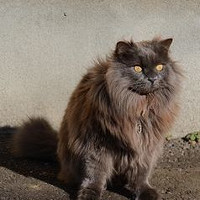|
A brief historical overview
|
In 1967, New York breeder Jennie Robinson bought two golden-eyed, chocolate-coated kittens, Thomas and Shirley, at a garage sale. The relationship between Thomas and Shirley is unclear: it's possible they're half-brothers. Jennie Robinson estimates the age of Shirley, the female, at six months and Thomas at just over a year. The actual origin of the kittens is unclear, and they are generally considered to be of undetermined breed. According to research carried out by Tracy Oraas in the late 1980s, they could be the result of cross-breeding in the UK to obtain the Angora breed.
In 1969, Shirley gave birth to her first litter of six kittens, all chocolate-colored. Jennie Robinson and her vet were impressed by the kittens' beautiful color, and the breeder decided to launch a breeding program in her “Neotype” cattery. The first members of this new breed were registered as “foreign longhairs” by the American Cat Association (ACA) in the early 1970s. |
General appearance
|
Havana brown, Nebelung, Somali and Oriental longhair were used in the Canadian development of the breed.
The Chantilly resembles the American Burmese, but is in no way related to it. Tracy Oraas makes it clear that the Burmese was never used in the Chantilly breeding program.
The Tiffany (or Tiffanie) has a similar name and is the cause of Chantilly's third name change. This is a semi-long-haired variety of English Burmese. Apart from the name, there is no link between the two breeds. According to Dr. Bruce Fogle, such naming confusion doesn't help either breed. |
Important proportions
|
| The Chantilly is a graceful, medium-sized, slender, elegant cat of semi-foreign midline type. Both bone and musculature are medium. |
Behavior / characteristics
|
Character traits are not described in the standards and are temperaments generally observed in the breed. Breeders refer to the breed as “The Chocoholics Delight”. The Chantilly's character is described as temperate, halfway between the placidity of the Persian and the dynamism of Oriental cats like the Siamese. Its pleasant, communicative voice is compared to a chirping or chirping sound.
Faithful and loyal, the Chantilly is very attached to its master, but aloof with strangers. Not very mischievous, they need a calm environment. Sociable, it can live in the company of dogs, children and other cats. The Chantilly can suffer from anxiety if left alone too often. Described as affectionate without being excessive, the Chantilly is considered the tenth friendliest cat breed by petmedsonline.com. |
Health
|
The Chantilly is a breed of solid health, with no specific illnesses. However, its digestion is sensitive, and its diet must be stable and not include too much corn. This cat needs a controlled diet to avoid becoming overweight. The thick, semi-long coat can easily hide the beginnings of obesity. Longevity is around ten years.
During childbirth, the female is said to labor longer than other breeds, but is not overly anxious. Kitten weaning is slow.
The Chantilly doesn't require much care. It has virtually no undercoat, and shedding is minimal; however, the coat should be brushed or combed daily, paying particular attention to the ruff around the neck and the hindquarters. It can quickly become tangled and knotted. Although no cat is free of free allergens (even the Sphynx, which is almost completely bare), the Chantilly sheds very little, even less when brushed, and people with mild allergies would do better with this breed.
The only particular point of attention is the ear: Chantilly has ears where earwax can accumulate. Checking each ear once a week, along with brushing or combing and dental care, will suffice to keep the ear canal healthy. |
Genetics
|
The Chantilly's long hair comes from a recessive gene. It must be present twice for the cat to have long hair. This gene is found in all cats with long or medium-length hair, such as the Maine coon or Persian.
The Chantilly carries both alleles of the agouti gene, which determines whether the coat is tabby or plain. The “A” allele is dominant and gives a tabby coat, while the recessive “a” allele gives a plain coat. |
|







 English (United Kingdom)
English (United Kingdom)